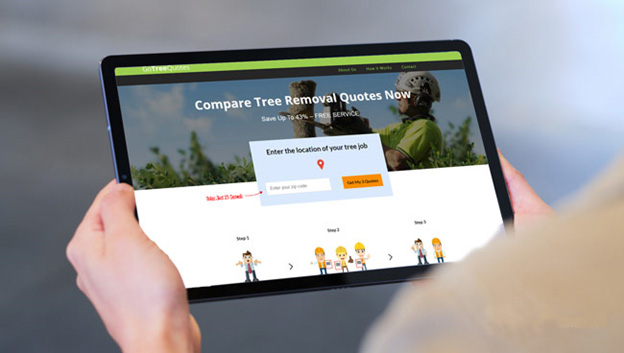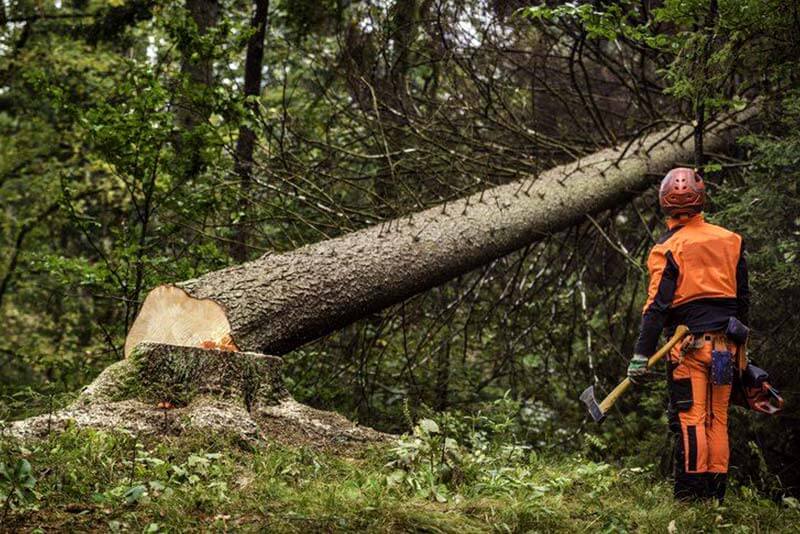The cost of dropping a tree depends on the tree’s height, trunk diameter, and surrounding obstacles.
On average, it costs between $210 to $600 to drop a tree. That works out to be about $19 per foot.
You will need to hire a qualified arborist to drop a tree, especially if any potential surrounding targets might be hit if things go wrong.
Below is a table showing the average cost to drop a tree depending on its height and size.
| Size of the tree | Height | Removal cost |
|---|---|---|
| Small | 15 - 30 feet | $210 - $250 |
| Medium | 15 - 30 feet | $250 - $380 |
| Large and Extra large | Over 60 feet | $420 - $600 |
Small trees
It will cost $210 – $250 to drop a small tree. It will take a skilled arborist no more than 30 – 40 minutes to prepare the site, drop the tree and have it ready to be cut up and taken away.
Medium size trees
These are trees of up to 60 feet in height. It costs $250 to $380 to remove medium size trees. It takes up to 4 hours to cut down a medium-sized tree. The arborist must ensure that it can be brought down without damaging other trees and property near it.
Large and extra large trees
For trees taller than 60 feet, it will cost $420 to $600 to remove. It may take up to 8 hours to cut down a large or extra-large tree. The branches on these trees are larger than those on smaller trees. The trunk is also larger and harder to cut through, increasing the complexity and cost.
Dropping a tree vs. tree removal
To drop a tree is to cut it from the base and get it safely to the ground. This specific task refers to cutting down a tree, but NOT cutting it up and removing it from your property. This is often carried on rural or semi-rural properties with plenty of room to work.
Tree removal is getting the tree on the ground and then removing it from the site. This is a lot more time-consuming and costs more money. For more on the cost of tree removal, please see our guide here.
Cost to drop a tree by tree type
The average cost to drop a tree varies widely depending on the type of tree. The table below shows how much it would cost to drop different types of trees, including pine, oak, palm, cedar, etc.
| Type of tree | Cost of removal |
|---|---|
| Oak | $200 - $2,000 |
| Pine | $200 - $600 |
| Palm | $200 - $420 |
| Cedar | $200 - $600 |
| Ash | $300 - $1,200 |
| Maple | $300 - $950 |
Different types of trees have varying difficulties when it comes to removal. The more difficult it is to remove the tree, the more you pay.
What determines the complexity of removal is the height of the tree and the hardness of the trunk. The harder the trunk, the more difficult it is to cut through. Therefore, removal takes longer and is charged more.
Further, tall trees have higher branches that are harder to reach. These trees will require the use of cranes which are expensive to hire. Therefore the cost of tree removal is high.
Cost by condition of the tree
Different species of trees have different physical conditions that may determine their ease or difficulty of removal.
Here are some conditions that determine how much you will pay for tree removal.
Trunks
Trees with multiple trunks are more complex to remove than trees with single trunks. Therefore, you will pay more to remove a tree with two trunks. Additionally, the larger the trunk’s diameter, the more you will pay.
Weak tree
If a tree is leaning dangerously, it requires more care to remove. A leaning tree will likely fall dangerously on other trees or buildings near it. Therefore, you will pay more to remove an overly leaning tree.
Health
The healthier a tree is, the more difficult it is to remove and the more you pay to remove it. Diseased trees have weakened trunks and branches. Diseased trees are easier to cut down. The cost of dropping a diseased tree is much lower than that of dropping a healthy tree.
Fallen tree
If a tree has already fallen by itself, you will pay only for moving it. Therefore, you will pay less than you would have paid for its removal. However, if the fallen tree falls on the property, it constitutes an emergency. An emergency tree removal costs more than an ordinary removal.
Protection status
Depending on where you live, there may be protected trees in your region. For most places, protected trees are not cut down unless in special circumstances.
Trees growing near utilities
If the trees in your land are near power or sewer lines, you can get them removed for free. Contact the utility company to remove the trees. If they agree, they will save you the cost of tree removal.
Additional services for dropping a tree
Professional tree removal companies may offer additional services that increase the cost of tree removal; These services include:
- Stump removal – It involves killing the roots of the tree. Grinding a stump is an additional charge for tree removal. It makes tree removal more expensive.
- Clean-up – After a tree is cut down, there is a lot of debris to clean up. For a few more dollars, the tree remover can chop up the tree into firewood or clean up all the debris to dump instead of leaving the task to you.
- Tree moving – It costs $700 to move a small tree. Larger trees cost up to $2,000 to move.
Cost for DIY removal vs. hiring a pro
Tree removal is an easy DIY task. However, it is only possible when working on small trees that do not require advanced tools. The more advanced tools you need, the higher the removal cost. Advanced tools for tree removal are hired by the hour. The longer it takes to remove a tree the more you pay.
To save on these costs and to avoid the dangers of tree removal, hire a professional tree remover. They will save you time and money.
Use this free service to hire a pro to drop your tree
Gotreequotes.com is a free tool for hiring professional tree removal service providers.
It connects homeowners to professionals in the following easy steps.
- Enter your zip code at the top of the tool.
- Fill in the form to provide more details about the tree removal service you need.
- You will receive three or four quotes and advice from professional and licensed tree removal service providers.













